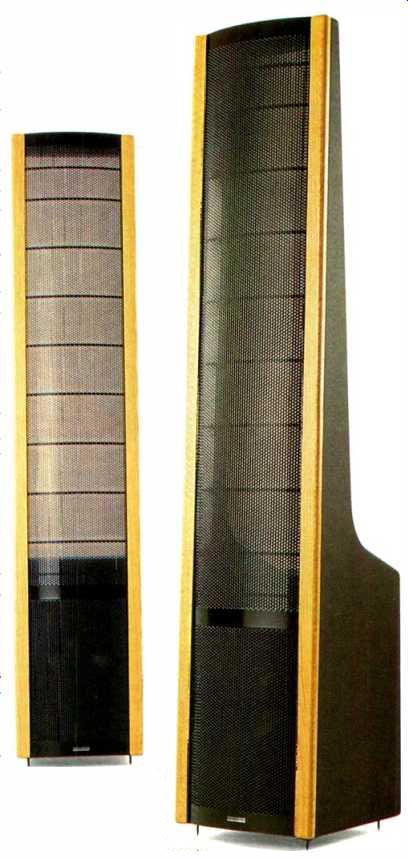
by IVAN BERGER
Company Address: P.O. Box 707, Lawrence, Kans. 66044; 913/749-0133.
I was in a hurry, the first time I put the Martin-Logan SL3s into my living room. I stuck them where they looked right, turned them on, and let out a deep "aaah!" But then I had to move the SL3s back against the wall to make room for a big gathering. Later, with the aid of a knowledgeable, sharp-eared friend and the copious instructions in the excellent owner's manual, I spent most of an afternoon trying to set them up exactly "right," to no avail. Frequency response sounded irregular, and imaging fell apart as soon as we moved our heads a few inches from the sweet spot. My friend left, and I abandoned the scientific approach, stuck 'em where they looked right, and went "aaah!" again. (For the record, the speakers are now about 3 feet from the front wall and about 4 feet from each side wall of my 14 x 22-foot room-a near-match of distances that should not work but, this time, does. They are also almost imperceptibly toed in.) This difficulty in setup stems from the speaker's dipole nature. Sounds pour with equal facility from the front and rear of the SL3's curved, electrostatic midrange/tweeter pan el. That means everything above about 250 Hz is coming at you not only from the speaker itself but, a few milliseconds later, from the wall behind it. Both sounds bounce a bit off other room surfaces as well. So dipoles tend to involve the room's acoustics in the final sound to a much greater extent than do conventional, monopole speakers. In the right room and properly positioned, dipoles can give you a very live and open sound-but making sure you have the right room and finding the proper position can be tricky. I'd expect the sound of my own setup to improve once I cover the wood-paneled wall behind the speakers with bookshelves, which should break up and disperse the reflections without massively absorbing them. Yet such is the nature of dipole sound that, until I install the shelves, I won't know for sure.
Below 250 Hz, the sound is not dipolar, because a conventional, 10-inch cone woofer in a small enclosure takes over. The crossover is a steepish 12 dB/octave and seemed seamless once I had the speakers properly placed.
The SL3's specs cite response of 30 Hz to 24 kHz, ±2 dB, and what I heard when the speakers were in the manufacturer-recommended position came pretty close to that (although I can't vouch for it all the way up to 24 kHz). In fact, I even reduced one speaker's bass output by 3 dB, using the two-position switch on its rear panel.
However, in the final position I picked, the bass seemed pretty well gone by 40 Hz, though the sound still seemed well balanced and not thin. If you're not too proud to use tone controls, a bit of bass boost solves the problem perfectly in all but the very low end; turning my bass-control knob to somewhere between 1 and 2 o'clock fixed things up without making the midrange too heavy. I'd want to use a subwoofer to discreetly augment tones below 50 to 60 Hz or so, but I could live a long time without one.
This is the kind of bass I'd expect from woofer systems this size, but not from speakers costing $3,195 per pair.
Yet I'm still going "aaah!" In my final setup, I get terrifically smooth, natural response and an image that's firmly locked in when I move around. Pink noise is remarkably smooth, though its balance does alter slightly when I move my head (an effect not noticeable on music). I also get an unprecedented feeling, in adjacent rooms, that there's live music in my living room, an effect I attribute to the SL3s' dipole nature.
I'm not getting as much depth as I did with other placements, but I am getting a wide spread. Obviously, I have a bit of fine tuning to go-those tricky dipoles again.
Since the SL3s stand 64 inches tall, they can overwhelm some rooms' decor. My wife nonetheless thought them quite handsome, perhaps because the partial transparency of the upper half keeps them from looking massive. That height can also make these speakers tippy on deep carpets, as their footprint is a mere 13 x 14 inches each.
Screwing the supplied spikes into the bottom of each cabinet solves that problem and also ensures you won't accidentally move your speakers out of their hard-found optimum positions. And the SL3s are noticeably shorter than the Sequel Its that they replaced. (The model name was changed, says Martin-Logan's Gayle Sanders, "because we could not see making sequels to Sequels indefinitely.") The input terminals, near the floor on the rear panel, have hexagonal metal nuts instead of the usual fluted plastic ones, which makes connections easier to tighten.
Removable links enable bi-wiring or bi amping. The terminals accept large spade lugs and pretty hefty wires, but not banana plugs. Recommended amplifier power is 100 to 200 watts per side, and rated sensitivity is 89 dB.
Like all electrostatics, the SL3s require a DC polarizing voltage, taken from a power supply that must be plugged into your wall.
However, rated power draw is only about 2.5 watts per side, and signal-sensing circuitry shuts the power off if there's no in put for a while. Turn-on time when signal resumes is just 2 seconds.
My overall reaction? The aaahs have it.
(Source: Audio magazine, Jan. 1996)
Also see:
Martin-Logan Monolith IIIx Loudspeaker (Equip. Profile, Sept. 1991)
Electrostatic Speakers: Theory and Practice -- Part 1 (Mar. 1989)
= = = =